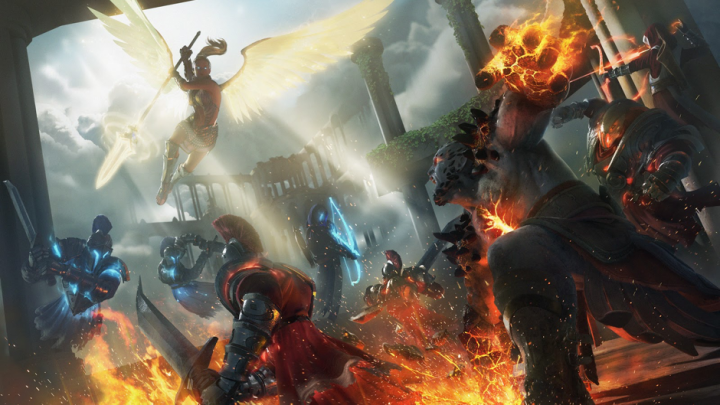10 tips for surviving as a freelance artist

Being freelance offers a varied working routine, and the chance to be your own boss – but the switch from studio life to self-employment can be jarring. To help anyone thinking of striking out on their own, we asked leading artists who work freelance, or have done so in the past, for their advice.
You can read their tips for surviving your first year of freelance below: they cover everything from how to find clients to staying inspired. I also contributed a tip myself. I’m a freelance writer rather than an artist, but the tip is about getting into a working routine – and procrastination is universal.
Main image: Number 41 – Akira fan art by Randy Vargas
1. Work for a company first
I would advise anyone wanting to be a freelance concept artist to start off working for a company. Too many people jump into the freelance lifestyle without having any experience on the job.
First, you need to know how fast you are. As a freelance artist, you will be responsible for giving estimates to clients for how long it will take you to complete a design.
Second, you need to find out what you’re actually worth. Making relationships with other artists [at a studio] will let you find out what they believe is a fair rate for your current skill level.
 Jerad Marantz, freelance concept artist
Jerad Marantz, freelance concept artist
Visit Jerad’s ArtStation gallery
2. Don’t be shy about promoting yourself
We live in harsh times where every job is competitive. Right now, the internet is your most powerful weapon for promoting yourself, so use it to its limits.
Promote yourself on forums, post your works on art-related websites, share other people’s works, and be social. In short, be everywhere. Someone will finally notice you.
But remember: not being shy doesn’t mean you have to be an asshole. Helping other people and sharing knowledge gathers people around you and makes you more attractive to potential clients.
 Darek Zabrocki, concept artist, Sony Computer Entertainment Europe
Darek Zabrocki, concept artist, Sony Computer Entertainment Europe
Visit Darek’s ArtStation gallery
3. Use social media
Posts in forums on art-related websites (DeviantArt, Conceptart.org) and online job listings (Behance, freelance.com) are very good ways to get those first commissions.
Companies rarely read anything from artists for hire, so look for existing posts from clients looking for artists. If their requirements match your skill set, send an email with all of the necessary information, showing interest in the project. This may take a few tries: being active in social networks and having an updated portfolio with your best work will help tremendously.
If you have to create your own announcement, read posts from other artists in the forum and see which ones worked best. Put yourself in the client’s skin: would you hire this person?
 Randy Vargas, illustrator and comics artist
Randy Vargas, illustrator and comics artist
Visit Randy’s ArtStation gallery
4. Don’t blow it when you meet face to face
Remember that your actions have a ripple effect in your industry. I have seen many great artists suffer for work not due to their ability, but to a lack of contacts to get them through the rough times.
When networking face to face, observe your actions as carefully as you would on a first date. Too many times I have been at a event where someone has gotten belligerent or obnoxious, or said something damaging, and ruined in one night a reputation that took them years to build.
 Brett Briley, freelance character artist
Brett Briley, freelance character artist
Visit Brett’s ArtStation gallery
5. Respect your clients
Some professionals will tell you that they just do their job and don’t care about their relationship with their clients. That’s fine, but there’s nothing wrong with developing a friendship with a client: if you’re on their good side, they will want to work with you more.
Keep in regular contact, discuss tasks via phone or Skype and, of course, avoid pushing deadlines drastically. It sometimes happens that you do need more time, but try to not exaggerate.
And make sure you always deliver your best-quality work. There is nothing worse than disappointing someone by delivering works two levels worse than the ones they saw in your portfolio.
 Darek Zabrocki, concept artist, Sony Computer Entertainment Europe
Darek Zabrocki, concept artist, Sony Computer Entertainment Europe
Visit Darek’s ArtStation gallery
6. Get organised
Creating an organisation system that works for you is the key to surviving your freelance career. Since you have no direct boss, no one will tell you to do this, so you must take the initiative.
If you can, schedule out your day, week and month, then create reminders for yourself. I try to create daily routines by setting myself ‘mini-goals’. Mini-goals are a way to set frequent targets without getting overworked or physically burnt out.
Your organisation system should be as simple as it can. Often, overly complex systems actually add complexity to your tasks. I prefer to use a paper journal that I have on me at all times, so I can reference and archive completed tasks. I find that analogue methods embed information much more clearly in my mind; software or online solutions are often just a crutch.
 James Paick, concept artist and creative director, Scribble Pad Studios
James Paick, concept artist and creative director, Scribble Pad Studios
Visit James’s ArtStation gallery
7. Get into a routine early
Finding the right rhythm is super-important. Work needs to become a habit, and that can take a while to train. Start with the big chunks of the day – breakfast, taking a shower, lunch, grocery shopping and preparing dinner – then start filling in the time between with work.
Do some sketches to warm up, and remember to take breaks. Don’t force yourself too much: it’s very easy to become stressed when you’re freelance.
 Titus Lunter, freelance concept artist
Titus Lunter, freelance concept artist
Visit Titus’s ArtStation gallery
8. Treat freelance like a nine-to-five job
Approach freelance life as if it were a full-time job. It’s easy not to start on time in the morning because no one is forcing you to – then end up working late into the evening to catch up.
You don’t literally have to work nine to five – I like to start earlier in the morning, then take a long lunch break; and I know people who actually prefer to work evenings – but you do have to commit to a routine. Finding a studio or shared space may help here: if you just focus on getting to ‘the office’ on time, you often find you’re in the mood to work once you get there.
Another benefit of working fixed hours is that you know when you can clock off without feeling guilty. Just because you can work weekends doesn’t mean that you should!
 Jim Thacker, editor, ArtStation Magazine
Jim Thacker, editor, ArtStation Magazine
Read other articles by Jim on ArtStation
9. Build an inspiration system
Organise your files creatively. There is a balance between making sure you can find archive material and allowing yourself to stumble upon random images to drive inspiration.
I like to create two distinct categories: reference material (material for understanding materials, design aesthetics, nature and so on) and inspirational material (other art work, screengrabs of films, colorr references, and so on). Within these main categories, I create sub-folders containing different artists’ work, references, photos, videos, and so on.
 James Paick, concept artist and creative director, Scribble Pad Studios
James Paick, concept artist and creative director, Scribble Pad Studios
Visit James’s ArtStation gallery
10. Value yourself
“If you aren’t getting paid for it, then it’s a hobby.” Those words from the legendary Syd Mead say it all. When you’re starting your freelance career, value yourself: don’t work for free or for credits only.
Unfortunately, a lot of clients easily find naïve starters who will work for nothing, or next to nothing. People like this lower everybody’s rates, and paint a bad picture of us as professionals.
If you aren’t certain how much should you be paid, there are articles online that will give you an initial idea. Rates are very personal: while some people take home $100 per day, others take home $1,000. Never hesitate to ask for more: if a client wants you, they will pay up – or at least negotiate.
 Darek Zabrocki, concept artist, Sony Computer Entertainment Europe
Darek Zabrocki, concept artist, Sony Computer Entertainment Europe



















